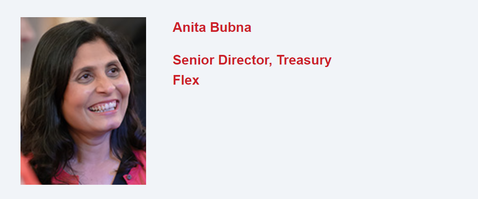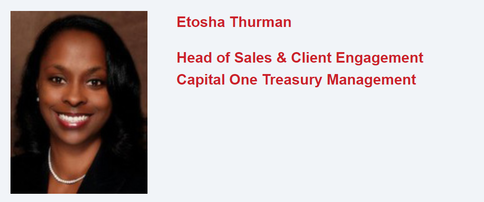|
"IN A WORLD OF FINANCIAL UNCERTAINTY, COST-CUTTING IS ESSENTIAL. HOW CAN TREASURY HELP? Kevin Daly, Assistant Treasurer, James Hardie Industries PLC Claudio Delgado, Manager, Treasury & Capital Markets, Actualize Consulting Anita Bubna, Senior Director, Treasury Flex Etosha Thurman, Head of Sales & Client Engagement, Capital One Treasury Management It is essential that treasury operates within a strong environment of process, control and reporting; if you can’t measure it, you can’t manage it. Capital management Funding: treasurers raise capital from debt and equity arkets. Once this capital is drawn down, the treasurer can influence the cost of utilising this capital on a day-to-day basis. There will be fixed costs associated with raising capital but there are variable costs in utilising certain debt capital, especially revolving facilities. Take the case of a USD revolving credit facility: the spread between one-week and three-month USD LIBOR is currently 37bps or US$38,000 on US$10m per annuum. Managing this debt on a more frequent basis is time consuming but you can offset this by implementing an efficient process and utilising your TMS. Cash flow forecasting: consistent, complete and accurate short-term cash flow forecasting cannot be understated in terms of the savings that can be achieved by treasury managing available cash, utilisation of loan facilities and ability to place cash in fixed term deposits. This includes the ability of treasury to have accurate forecasts by currency so that a long position in one currency can be utilised to fund a short position via the treasury function. Working capital management: I also call out management of working capital as an area that can generate significant cost savings. The three elements of working capital – receivables, payables and inventory – all have an impact on the group’s cash/capital, and on the cost paid for that capital. It is quite a complex area because it requires interaction and buy-in across business operations, with multiple stakeholders with competing demands. Transactions Cash management/bank accounts: treasury has direct control over its bank account and cash management structures, and can influence how other parts of the business manage their cash. This requires consistent and ongoing reporting, analysis and ownership. Ownership is key to ensure areas identified in reporting are actioned. Foreign exchange: foreign exchange (FX) trading platforms enable full visibility on ‘best price’ execution which can be linked to the TMS for straight through processing. This also enables reporting and analysis to ensure that treasury has visibility on share of wallet which can be leveraged for pricing on other services with banks. Services Treasury needs to ensure that it is only paying for services it requires and is achieving competitive pricing for these services. Treasury is a dynamic function, and requirements will change year-on-year. An annual review of services can identify opportunities for cost saving. Reporting, communication and technology The key to achieving cost savings and efficiencies is consistent reporting on activities, communication to those who can action change, and explaining the rationale. Technology should be utilised to support an efficient process and enable identification of costs by developing and continuously enhancing your reporting. The management methodology, ‘Plan-Do-Check-Adjust’, is a great continuous improvement tool that will facilitate cost saving within any treasury function. The treasury team has many ways to approach growing cash flow demands while reducing their costs. A few of the most common practices we see many of our clients engage in are interdependent, such that they must be executed in parallel. Here are a few steps to begin the transformation journey. Standardise and streamline the treasury processes Firstly, the treasury team must understand where the company’s treasury function is today. A clear understanding of each treasury process, and who is executing them, will provide the baseline for all future efforts. The next step is to evaluate each process, and redesign them, such that they are standardised and more efficient across the organisation. This analysis will uncover potential overlap or duplication of efforts in multiple areas within the organisation. By eliminating non value-added activities and avoiding duplication of efforts, treasury is helping to cut costs. Obtain cash visibility to optimise liquidity One guaranteed strategy to reduce costs is to have accurate visibility of available cash on a daily basis across all or most bank accounts. This transparency will uncover trapped cash within the organisation that will allow treasury to concentrate all excess cash in order to reduce debt (in leveraged organisations) or to optimise investments (in cash-rich organisations). In the former case, treasury is reducing interest costs, and in the latter, treasury is increasing interest profits. Transform the treasury organisation to a more centralised model A natural consequence of standardisation across treasury processes is the ability to execute them with an optimised number of resources. Avoiding duplication of efforts will release resource time across the organisation, so they can focus on other value-added activities while at the same time reducing the labour cost of treasury resources to execute the essential treasury tasks. Leverage treasury technology to make it all work Treasury technology is evolving constantly. We are seeing the integration of artificial intelligence, business intelligence, blockchain and API into treasury applications. Treasury teams must make it a mandate to evaluate and implement the appropriate technologies into the day-to-day operations. Treasury management systems allow for the automation of standard treasury processes, the connectivity to financial institutions to provide cash visibility and optimise liquidity, and straight through processing from internal systems (ERPs) to the financial institutions with security and speed. Technology enables small treasury teams to execute a broad range of treasury processes across multiple geographies. By no means is this an exhaustive list of treasury initiatives to help reduce costs. There are other opportunities such as bank relationships, currency risk management, debt management, investment management, payments and fraud control that must be explored as part of the overall treasury assessment. Treasury must continue to be in an innovating mindset in order to continue cost-cutting efforts while remaining relevant to the organisation. If you are looking to find ways to optimise costs, why not look at the following categories and see if there are opportunities for you to explore further? Bank fees: do you understand the different items for which banks are charging you? Account analysis statements can be cryptic and can run into several pages. Ask your banks if they can provide an Excel version of the fees so that you can analyse the 20% of categories that typically contribute to 80% of costs. Also, ensure you have reporting in place to provide analysis of fee trends and to automatically flag any increase beyond a certain threshold. Do you earn an earnings credit rate (ECR) from banks to help offset fees? When was the last time you analysed whether you have sufficient fees to offset ECR credits fully? Converting accounts to an interest-bearing account may be more beneficial. In the US, some banks charge Federal Deposit Insurance Corporation (FDIC) fees on balances. It may seem like these are fees that go to the government but actually these are regulatory costs that the banks are trying to pass on to customers. This item can mask the true interest you earn from the bank. Do you have bank accounts that have not seen transactions for several months and could be closed? Are there lockboxes open which see a minimal number of cheques? Could virtual accounts make sense for your organisation as a way of consolidating the number of bank accounts you have? Do you have a large proportion of payments via wire, when ACH or SEPA could be used? Interest costs: there are many ways to evaluate and optimise the interest cost expense and income for treasury:
Transaction costs: do you have a high volume of transactions? Treasury management systems can help reduce manual work, streamlining compliance activities, and managing communication across multiple subsidiaries. Where automation is not possible because of complexity or limitations in your business model, it’s worth exploring shared services centres. Software subscriptions: are you still paying for software subscriptions for systems that you no longer use? Have you looked at competitor systems to compare the value being delivered by your current systems? Some companies with robust IT support dedicated to finance may be able to build simple in-house systems that are more customised to your business needs but without annual subscription and maintenance costs. The Treasury organisation assists in managing costs in a number of key ways. While the Treasury organisation itself is not the ultimate decision maker for how and where to cut costs, it is responsible for rapidly and accurately executing these cost-cutting decisions. Thus, Treasury is a key player that enables a company to realise cost savings in a timely manner.
Treasury ensures that payment templates and payment approval workflows are in place. For instance, if there is a change to a lower cost supplier, Treasury ensures that the new supplier can receive and reconcile payments, and there is no disruption to the company’s supply levels and business operations. It oversees the reorganisation of operating accounts and sets up expedited processes for collecting and disbursing funds as one would see in the case of an exit from a business unit. Treasury ensures that funds are available to make accurate payroll and severance payments, and that the correct information accompanies these payments. In addition, through its own operations, the Treasury department can help mitigate costs by ensuring that a company can effectively manage its cash flows while maintaining liquidity, optimising cash resources, and obtaining access to financing facilities that minimise borrowing costs. Technology also plays a major role in this effort. With the automation of key treasury functions such as reconciliation and payment initiation and approval, a company can reach settlement faster. This enhanced speed can dramatically mitigate the associated liquidity and payment risks in addition to the costs associated with delays in processing. Also, with fewer risks and more control over payment and information float, treasurers can view and forecast their cash positions with much greater precision to gain a better view of cost-cutting opportunities in their working capital. For example, these enhanced cash positions can provide more power over payment ability, which can be leveraged with suppliers to lower the costs of their working capital financing by negotiating better terms for accounts payable. In addition, treasurers may be able to gain a more accurate view of their cash positions and lower unnecessarily high revolving lines of credit which can dramatically cut interest payments or bank fees. By utilising these insights, treasurers can spend less time understanding where they stand and more time making better cash management decisions.
0 Comments
|
News OverviewLatest release news and tips for your Kyriba implementation. Categories
All
Actualize ServicesArchives
December 2020
|
- Home
- News
-
Kyriba ▼
- On-Boarding
- Bank Account Management
- Bank Connectivity
- Bank Fee Analysis
- Bank Statements
- Business Intelligence
- Cash & Forecasting
- Cash Accounting
- Financial Accounting
- Financial Transactions >
- Fraud & Compliance
- GL Reconciliation
- Hedge Accounting
- In-House Banking
- Netting
- Payments
- SSO/SMS
- System Administration
- Valuations
- Mid Market ▼
- Best Practices ▼
-
Actualize Resources ▼
- New Kyriba Consultants
-
Technical Resources ▼
>
- More Education ▼ >
- Bank Account Management
- Bank Fee Analysis
- Bank Connectivity
- Bank Statements
- Kyriba Reporting ▼ >
- Cash & Forecasting
- Cash Accounting
- Core Data
- Connectivity ▼ >
- Data Exchange
- Financial Accounting
- Financial Transactions
- Fraud & Compliance
- GL Reconciliation
- In-house Banking
- Liquidity Planning
- Market Data & MTM
- Netting
- Payments
- Supply Chain Finance
- System Admin & SSO
- Valuations & Risk, Hedge Accounting
- News & General ▼ >
- Project Resources ▼ >
- RPA
- Sales and Account Management
- Training Portal Requests
- Contact






 RSS Feed
RSS Feed